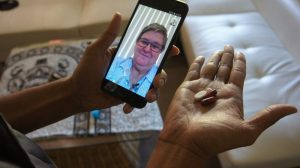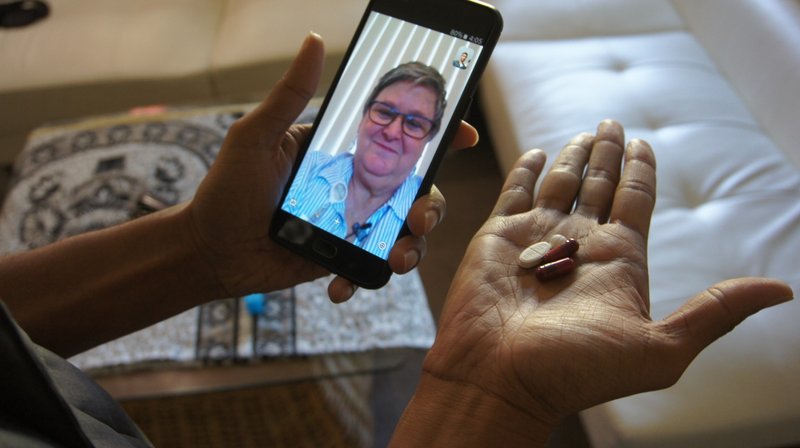By Emma Phillips
The Covid-19 pandemic has drastically changed the American healthcare field in many ways, one being the rise in popularity of telemedicine. Some of the first examples of modern telemedicine came about in the 1950s and 1960s, when a “closed-circuit television link was established between the Nebraska Psychiatric Institute and Norfolk State Hospital for psychiatric consultations.”[1] It became a way to link mental professionals across great distances, aiding in their ability to consult psychiatric patients from afar without needing to see and diagnose patients in person. More recently, even before the Covid pandemic, telemedicine has become popularized through the internet. Telephone and video appointments with doctors have increased dramatically over the few decades. Regardless, up until the beginning of the pandemic in 2020, in-person doctor’s visits were still largely regarded as the norm.
One of the reasons that this is the case is the Controlled Substances Act. Under 21 U.S.C. 829(e), telemedicine conferences are generally not sufficient mediums through which doctors can prescribe controlled substances to their patients- an in-person consultation is required instead.[2] The intent behind this was clear; the legislature wanted to insure the accuracy of prescription of controlled substances through in-person evaluations, since these substances carry risk of abuse. Since medical professionals found in-person evaluations to be the most accurate assessment of whether they should prescribe these medications, this provision was written into law.
But the Controlled Substances Act does state instances in which there may be exceptions to this provision, one of which is illustrated in 21 U.S.C. § 802(54)(D).[3] This provision allows that, in the case of a national public health emergency (which is designated under 42 U.S.C. § 247(d)[4]), schedule II-schedule V substances, which include, but are not limited to oxycodone, methadone, and morphine.[5]
The Covid pandemic triggered this exception; in January of 2020, the Secretary of the Department of Health and Human Services issued a Public Emergency Declaration, and the DEA updated its website announcing the change to the telemedicine prescription policy.[6] The statement stated that this change would be in effect for the duration of the public health emergency, or essentially, the duration of the pandemic.[7] Essentially, this exception allows the prescription of controlled substances so long as the prescription is issued for a legitimate medical purpose by a practitioner acting in the usual course of her professional practice, the telemedicine communication is conducted using an audio-visual, real-time, two-way interactive communication system, and the practitioner is acting in accordance with applicable federal and state law.[8]
So what does this mean for the future of telemedicine, and how will this affect patients who depend on medication that qualifies as a controlled substance? A few glaring issues almost immediately come to mind. First and foremost, 21 U.S.C. § 802(54)(D) contains a provision that allows the exception to be limited to “patients located in [certain] areas, and such controlled substances, as the Secretary, with the concurrence of the Attorney General, designates.”[9] This essentially allows the for the unequal application of this exception; as time goes on, if restrictions continue to lift, only certain areas may be able to take advantage of it.[10] Secondly, and more obviously, the fact that a video conference is necessary to obtain a prescription or a refill disproportionately affects lower income communities, who may not have consistent access to internet or a webcam. By forcing those in this position to choose between going without medication or risking exposure to the virus, the switch to telemedicine during pandemic times creates a massive disadvantage to an already vulnerable population, and this problem is not one that is easily solved.
Ultimately, the ability to prescribe controlled substances via telemedicine during the coronavirus pandemic does help to minimize the risk of infection with the virus to a large proportion of the population. However, the way the law is structured also exposes many holes in its efficiency and allows for dramatically inequal application of the exception. If this pandemic is to last much longer, the legislature should take a close look at how this section of the U.S. code can be made more accessible to all communities, and how they can improve upon it in the future, should they need to.
[1] Thomas S. Nesbitt, M.D., M.P.H., The Evolution of Telehealth: Where Have We Been and Where Are We Going? National Center for Biotechnology Information (2012) https://www.ncbi.nlm.nih.gov/books/NBK207141/.
[2] 21 U.S.C. § 829(e).
[3] 21 U.S.C. § 802(54)(D).
[4] 42 U.S.C. § 247(d).
[5] Controlled Substance Schedules (2020) https://www.deadiversion.usdoj.gov/schedules/.
[6] Thomas Sullivan, DEA Allows Controlled Substance Prescriptions to Be Issued Via Telemedicine (Apr. 9, 2020) https://www.policymed.com/2020/04/dea-allows-controlled-substance-prescriptions-to-be-issued-via-telemedicine.html.
[7] Id.
[8] Id.
[9] 21 U.S.C. § 802(54)(D)(ii).
[10] Thomas Sullivan, DEA Allows Controlled Substance Prescriptions to Be Issued Via Telemedicine (Apr. 9, 2020) https://www.policymed.com/2020/04/dea-allows-controlled-substance-prescriptions-to-be-issued-via-telemedicine.html.

Image Source: https://apnews.com/article/189668d9268243b2921a6a0764ddd511
